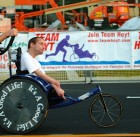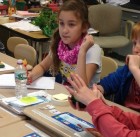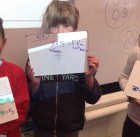Viewing: Common Core
February 28, 2016
Changing Math Lessons for Unit 6
As you may know, I am one of the two teachers from the PGS fourth grade team who are on the math curriculum committee for our grade. With three counterparts from RBS and our district K-6 math coach, we meet ever few months to continue the process of revising our math instruction. (I’ll be out next Monday morning to attend one of our curriculum work days.) When we transitioned to align with the Common Core two years ago, we found that our former series, Everyday Mathematics, was no longer appropriate in its entirety. As we rewrote our fourth grade math curriculum, we worked to pull materials and resources that were best suited for teaching a given concept or skill. Sometimes those resources came from individual Everyday Math lessons that we thought fit the objectives particularly well, sometimes they came from OnCore (which accounts for most of the worksheets you have seen come home), and occasionally we pulled in miscellaneous resources (including SMART Notebook lessons from SMART Exchange, homework or classwork worksheets from different sources, etc.)
 Four our new math unit, which focuses on adding, subtracting, and multiplying fractions, we are using a new set of resources that we piloted last year. EngageNY is a resource made available by the New York State Department of Education. The state has developed Common Core-aligned lessons and resources for each grade, and we have found that the lessons are well-structured, include valuable resources, and integrate an appropriate amount of rigor (while not being unreasonably difficult). As a team, we have found that the program is particularly well-suited for teaching fractions (especially the concepts covered in the current unit). You and your fourth grader will see a few changes, and plenty of similarities too:
Four our new math unit, which focuses on adding, subtracting, and multiplying fractions, we are using a new set of resources that we piloted last year. EngageNY is a resource made available by the New York State Department of Education. The state has developed Common Core-aligned lessons and resources for each grade, and we have found that the lessons are well-structured, include valuable resources, and integrate an appropriate amount of rigor (while not being unreasonably difficult). As a team, we have found that the program is particularly well-suited for teaching fractions (especially the concepts covered in the current unit). You and your fourth grader will see a few changes, and plenty of similarities too:
- Lessons are more structured. While worksheets are still included for practice at the end of lessons, they are less emphasized than other lessons we have considered. They will continue to be completed during math rotations.
- The word “tape diagram” is introduced. It means the same as “bar model” (which your kids should certainly be able to explain to you!) Both terms will be used interchangeably. I think it’s a different term because of copyright issues. That said, you may have heard your students discuss the differences between tape diagrams and area models late last week. These are very similar visual models, but they do have differences. Ask your fourth grader!
- Lessons continue to begin with a number talk, which allows students to practice mental computation skills and to discuss different methods in which they solved a given problem.
- Lessons may end with exit tickets. These are very short (one or two question) worksheets that let teachers get a quick overview of student proficiency. They can be used in different ways, including informal assessments, warm-ups for the next day, etc. I use them sporadically.
- Classwork and homework worksheets have the potential to be more lengthy. There are times when I may ask students to complete a whole assignment. Other times, I may ask kids to complete certain sections. Overall, however, the assignments will have more items than the five-item worksheets you remember from OnCore. Additionally, most items are open-ended, as compared to the OnCore multiple choice homework worksheets. This allows students to better apply their skills. Homework worksheets more closely resemble the classwork pages, so a correct sheet from classwork can help a student as he or she completes the homework page. You’ll notice that I (almost) always will have kids bring home their classwork worksheets. Even though they may not be entirely completed (for the reasons explained above), I think they can often be helpful guides as kids complete their homework. Students do NOT need to complete the unanswered classwork questions, unless that’s specifically written as part of the night’s homework assignment. This practice should be familiar, as I did the same thing in previous units when we used OnCore materials.
As with all changes to our instructional plan, we will continue to meet as a team to review our progress, discuss what we like and don’t like about the new lessons, and revise our plans based on our experiences from students.
Please feel free to reach out to me if you have any questions!
Posted in Class Updates|By Jon Moss
February 27, 2015
Changing Math Lessons
As you may know, I am one of the three teachers from the fourth grade team who are on the math curriculum committee for our grade. With three counterparts from RBS and our district K-6 math coach, we meet ever few weeks to continue the process of revising our math instruction. When we transitioned to align with the Common Core, we found that our former series, Everyday Mathematics, was no longer appropriate in its entirety. As we rewrote our fourth grade math curriculum, we worked to pull materials and resources that were best suited for teaching a given concept or skill. Something those resources came from individual Everyday Math lessons, sometimes they came from OnCore, and occasionally we pulled in miscellaneous resources (including SMART Notebook lessons from SMART Exchange, homework or classwork worksheets from different sources, etc.)
 Four our new math unit, which focuses on adding, subtracting, and multiplying fractions, we have chosen to pilot a new resource. EngageNY is a resource made available by the New York State Department of Education. The state has developed Common Core-aligned lessons and resources for each grade, and we have found from small pilots that the lessons are well-structured, include valuable resources, and integrate an appropriate amount of rigor (while not being unreasonably difficult). As a team, we have chosen to pilot this program for our new math unit. You and your fourth grader will see a few changes:
Four our new math unit, which focuses on adding, subtracting, and multiplying fractions, we have chosen to pilot a new resource. EngageNY is a resource made available by the New York State Department of Education. The state has developed Common Core-aligned lessons and resources for each grade, and we have found from small pilots that the lessons are well-structured, include valuable resources, and integrate an appropriate amount of rigor (while not being unreasonably difficult). As a team, we have chosen to pilot this program for our new math unit. You and your fourth grader will see a few changes:
- Lessons are more structured and include more instructional support. While worksheets are still included for practice at the end of lessons, they are less emphasized than other lessons we have considered.
- The word “tape diagram” is introduced. It means the same as “bar model” (which your kids should certainly be able to explain to you!) Both terms will be used interchangeably.
- Lessons begin with a number talk, which allows students to practice mental computation skills and to discuss different methods in which they solved a given problem.
- Lessons end with exit tickets. These are very short (one or two question) worksheets that let teachers get a quick overview of student proficiency. They can be used in different ways, including informal assessments, warm-ups for the next day, etc.
- Classwork and homework worksheets have the potential to be more lengthy. There are times when I may ask students to complete a whole assignment. Other times, I may ask kids to complete certain sections. Overall, however, the assignments will have more items than the five-item worksheets you remember from OnCore. Additionally, most items are open-ended, as compared to the OnCore multiple choice homework worksheets. This allows students to better apply their skills. Homework worksheets more closely resemble the classwork pages, so a correct sheet from classwork can help a student as he or she completes the homework page.
As with all changes to our instructional plan, we will continue to meet as a team to review our progress, discuss what we like and don’t like about the new lessons, and revise our plans based on our experiences from students.
Please feel free to reach out to me if you have any questions!
Posted in Class Updates|By Jon Moss
April 22, 2014

Learning About Timelines through Team Hoyt
Our class has been working to learn about timelines lately as part of a social studies and ELA (English/Language Arts) integrated unit. The Boston Marathon was perfectly timed to be a valuable teaching tool for this study. Each year, I talk to the kids about two remarkable athletes: Dick and Rick Hoyt. Dick Hoyt is a father who, each year, runs in the Boston Marathon and pushes his son, Rick, who has cerebral palsy. They are true inspirations, just like the athletes yesterday who found a fellow marathon runner who had collapsed just shy of of the marathon’s end and carried him across the finish line. The Boston Marathon is full of remarkable athletes who model outstanding character, sportsmanship, and integrity!
I came across an article that taught a bit about Dick and Rick Hoyt’s amazing history, and I immediately saw the potential for it to be used as a learning tool for our study of timelines. We read the article in class today, and for homework, kids are identifying and writing short blurbs about the different events listed in the article. (Just a couple of words per event is fine.) We’ll use the kids’ ideas as a jumping off point for making a timeline tomorrow.
The article does mention (in general terms) the attacks that happened at last year’s Boston Marathon. We discussed in class only that something sad happened and that some people were injured or lost their lives, although some students (on their own) brought up more detail about what had happened when we discussed the marathon yesterday. I didn’t want to go into any significant detail about what had happened, and I refocused the discussion to the message of perseverance and honoring others (since Dick and Rick ran the marathon yesterday as a tribute to those who were affected by the attacks last year.
You can except, over the next few years, to see an ongoing integration of ELA and social studies. The two fit together very well since the Common Core places an increased emphasis on non-fiction reading and writing, and articles such as this give teachers a wonderful opportunity to bridge social studies work with literacy work. Our next step in our timelines study will have the kids partner up to read articles about a famous figure from history and to develop a timeline based upon the information they pull from the article. Stay tuned!
Posted in Class Updates|By Jon Moss
April 21, 2014

SBAC Practice
We’ve been working a lot on practicing for the upcoming SBAC tests! Our new computer lab is open for business, and it’s a wonderful environment for working on a variety of activities, despite the fact that most (but not all) of our work there has been SBAC-related. Because this is a pilot test year, please remember that neither families nor schools will receive score reports for individual students. Our goal this year has been to help students develop the skills to complete this computer-based testing, which kids have never had to do before. When we’re in the computer lab practicing, our focus has been on technical skills like logging in with Session IDs, marking questions for review, and how to select answers, less on the academic skills being assessed on the tests. (Of course, our IN-CLASS time is intensely focusing on these academic skills, since the skills being assessed on the rigorous SBAC tests are aligned with the Common Core, which guides our classroom work.) My message to the kids has been one encouraging them to relax, not stress, and just to do the best they can.
Looking to practice for the SBAC tests? Visit: http://sbac.portal.airast.org/
Need a video to walk you through the process? Click here! (I’m not sure if it will work on tablets. You might need a computer running Flash to watch this video.)
As always, please feel free to reach out to me if you have questions about the SBAC tests or our preparation!
Posted in Class Updates, Learning Resources|By Jon Moss
March 26, 2014

Fraction Fanatics!
Students in room 209 are quickly becoming fraction EXPERTS! Our first fraction unit focused primarily on understanding and interpreting fractions, finding common denominators, and comparing fractions. After reviewing skills during a fun game of Math Jeopardy, kids were assessed on their skills, and then we began our new fractions unit. This unit focuses more on mixed numbers (and improper fractions) along with performing calculations with fractions. As always, I’ll continue to post support videos when we come to challenging concepts.
Posted in Class Updates|By Jon Moss
March 19, 2014

One Problem, Multiple Strategies
Most adults remember learning specific strategies for different mathematical processes. We learned a specific strategy for multiplying numbers, for adding fractions, and for rounding large figures. One of our focuses in math this year is to recognize that there are many strategies that students can use to solve a particular problem. In the fall, as kids learned multiplication skills, I think we covered six or seven different strategies. This might seem like overkill to you, but I should point out that EACH of those strategies resonated with at least one student in class who said that it made particular sense to him or her. We all think about math differently, so it’s reasonable to conclude that some strategies make more sense than others to different learners. Similarly, in this fraction unit, we’ve looked at many different ways in which kids can compare fractions, with each one offering pros and cons for students.
Posted in Class Updates|By Jon Moss
